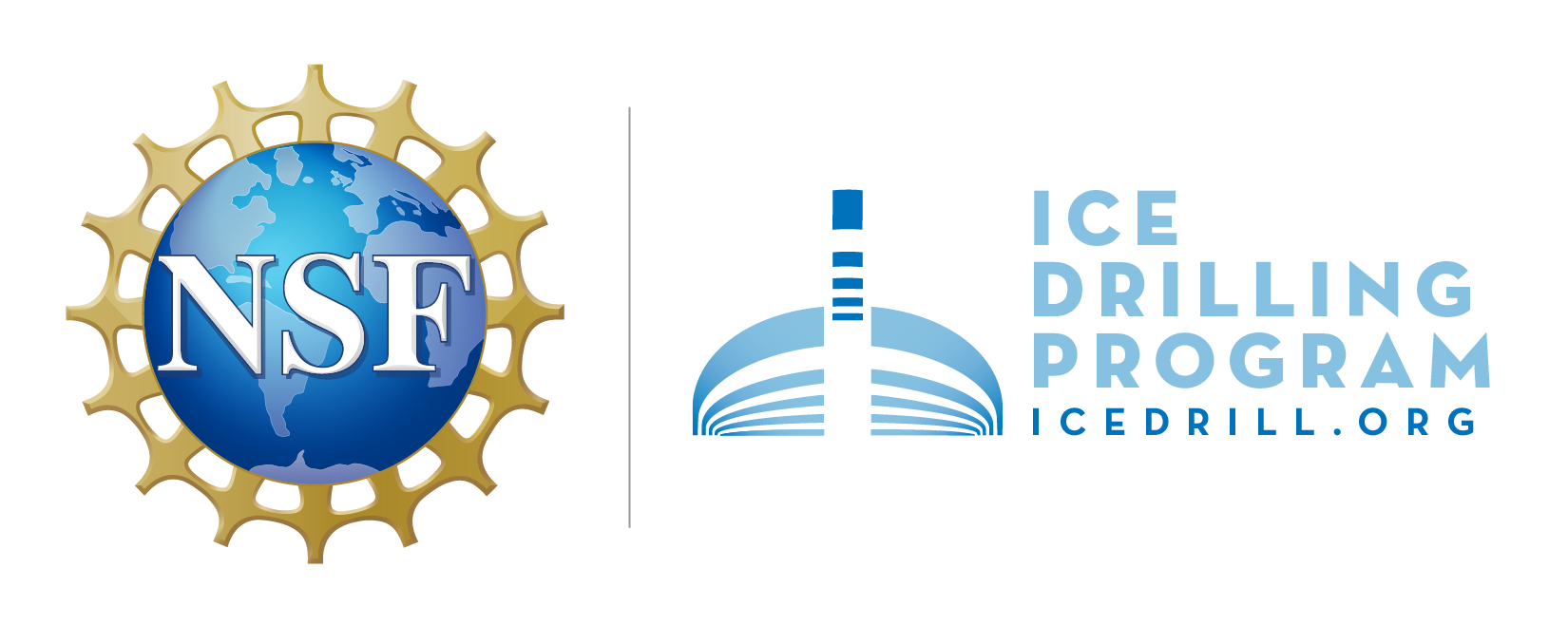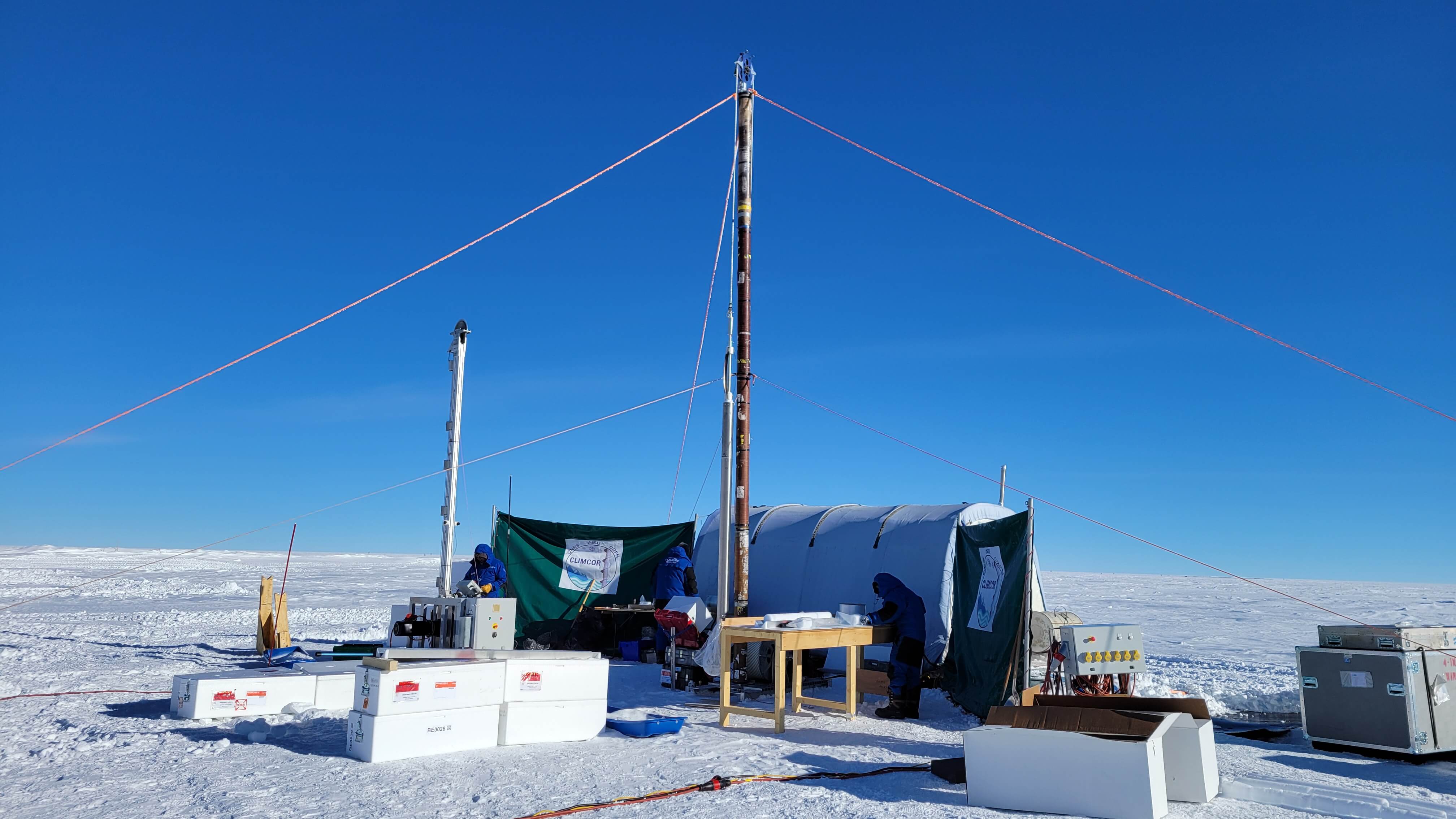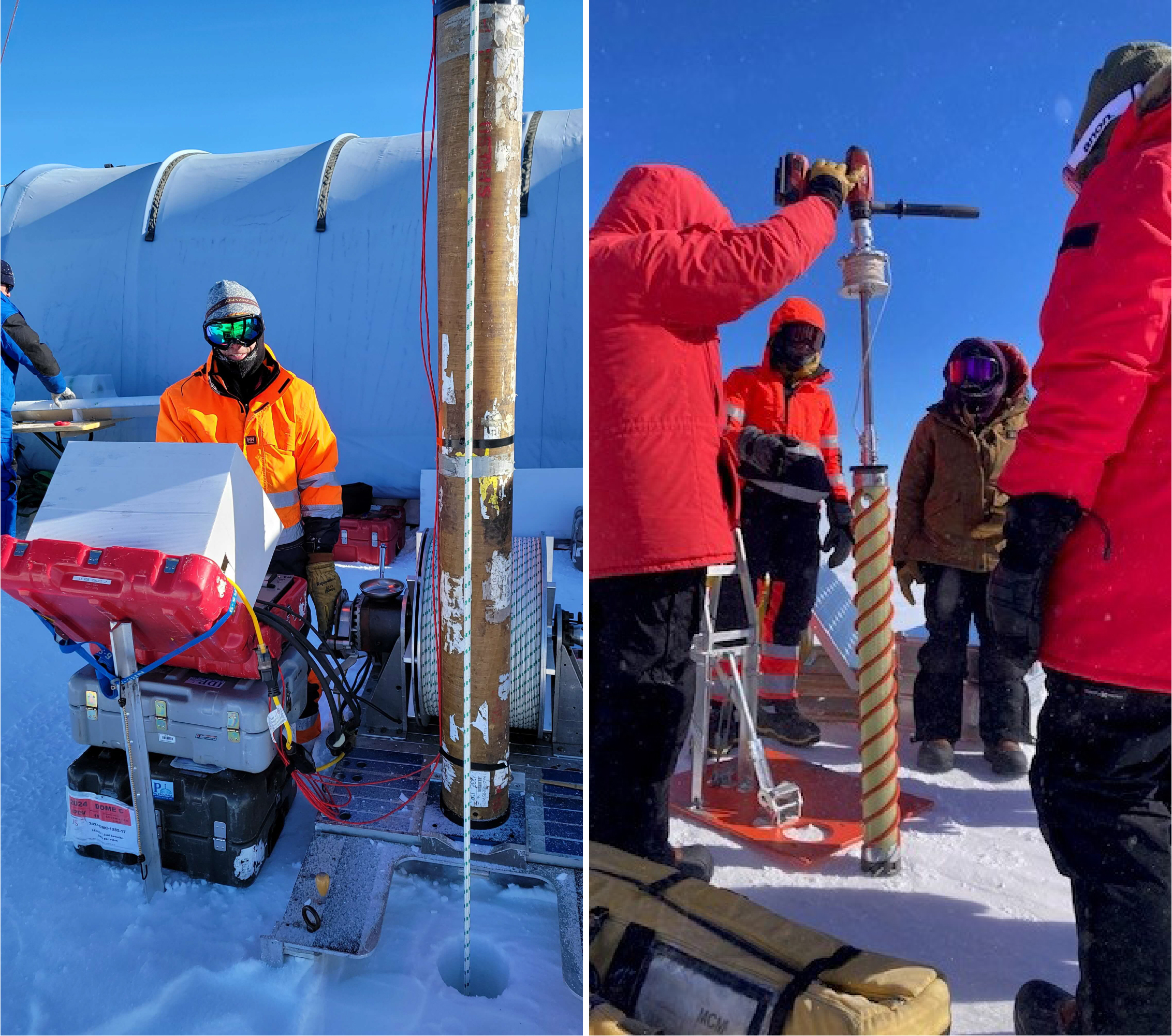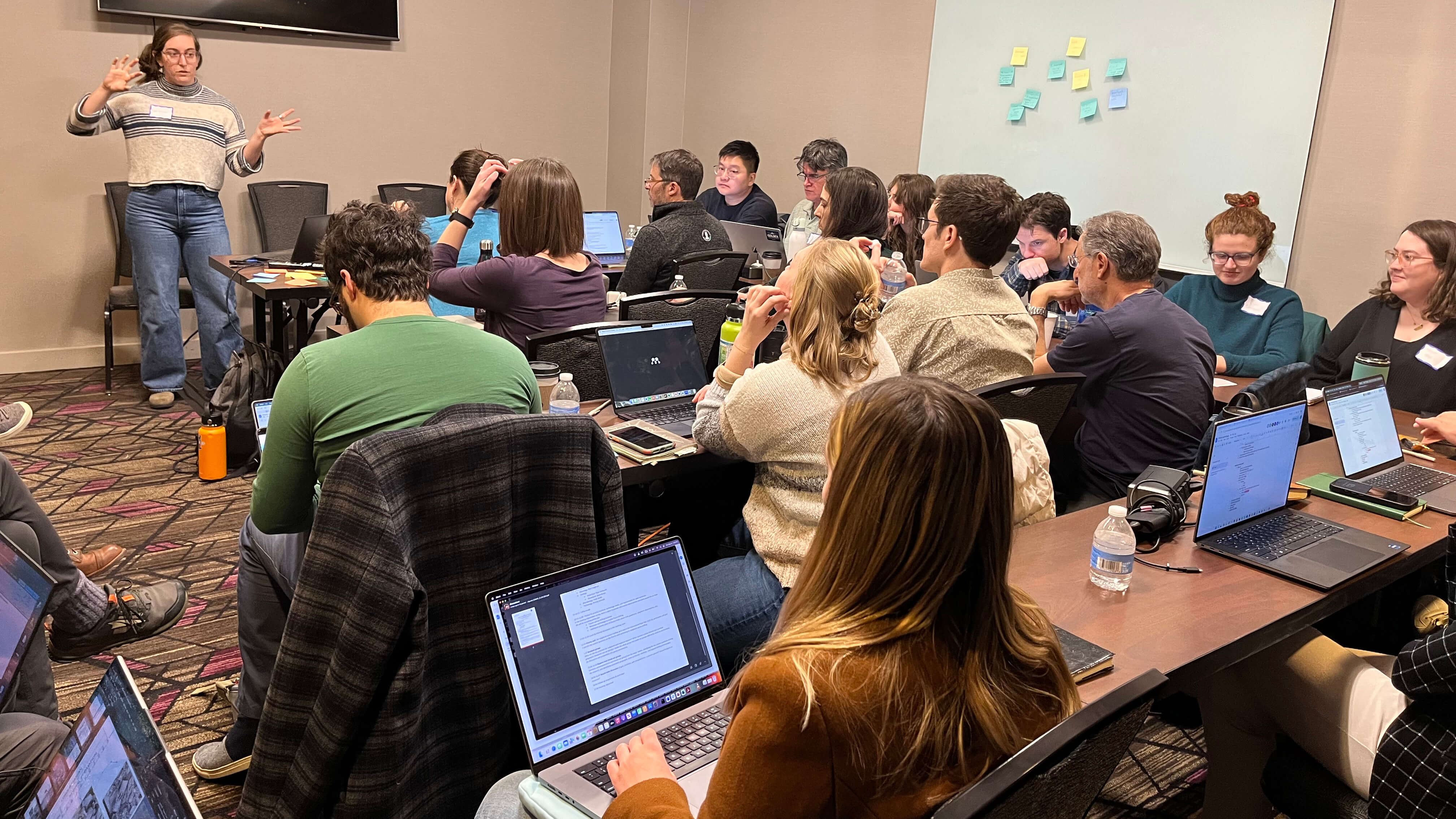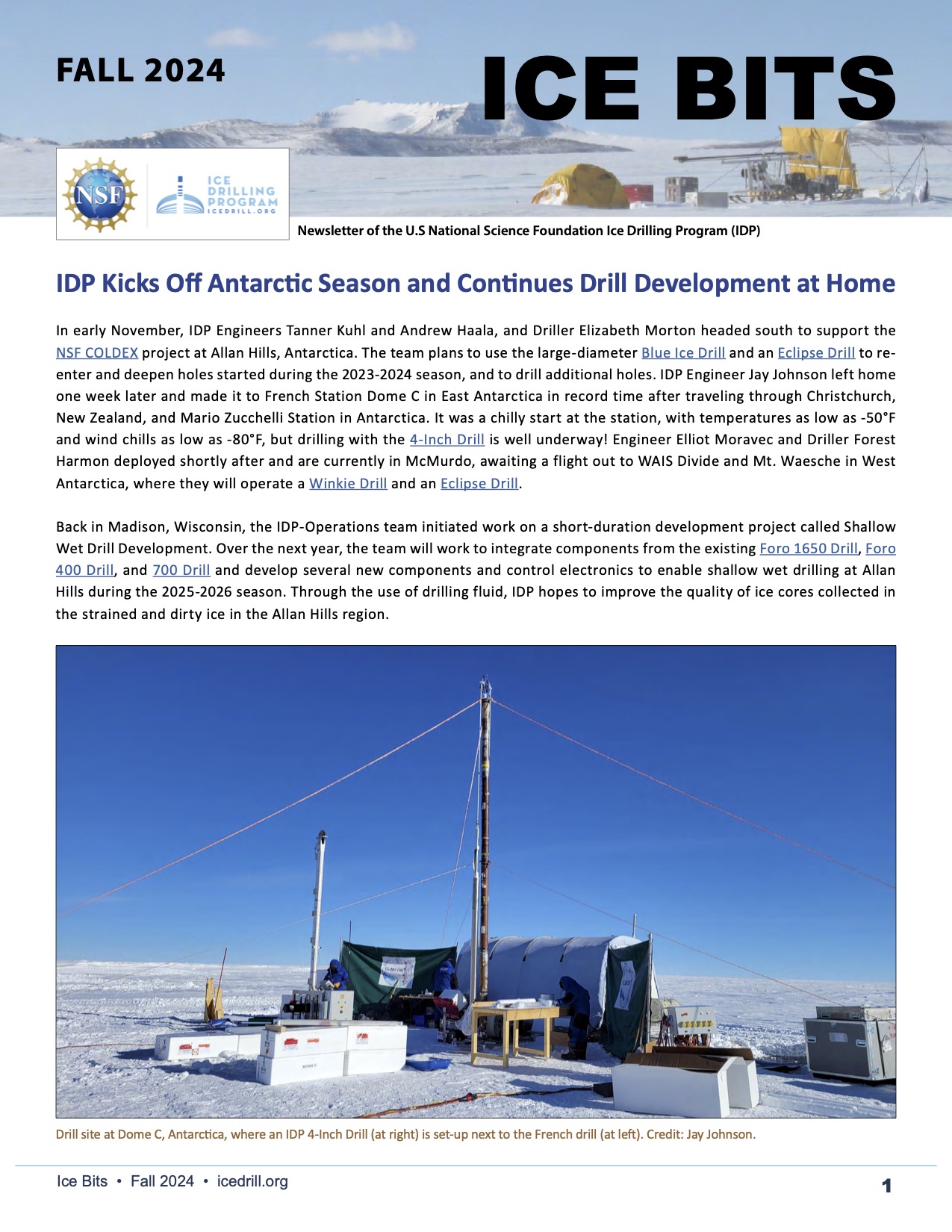IDP Kicks Off Antarctic Season and Continues Drill Development at Home
- Fieldwork
In early November, IDP Engineers Tanner Kuhl and Andrew Haala, and Driller Elizabeth Morton headed south to support the NSF COLDEX project at Allan Hills, Antarctica. The team plans to use the large-diameter Blue Ice Drill and an Eclipse Drill to re-enter and deepen holes started during the 2023-2024 season, and to drill additional holes. IDP Engineer Jay Johnson left home one week later and made it to French Station Dome C in East Antarctica in record time after traveling through Christchurch, New Zealand, and Mario Zucchelli Station in Antarctica. It was a chilly start at the station, with temperatures as low as -50°F and wind chills as low as -80°F, but drilling with the 4-Inch Drill is well underway! Engineer Elliot Moravec and Driller Forest Harmon deployed shortly after and are currently in McMurdo, awaiting a flight out to WAIS Divide and Mt. Waesche in West Antarctica, where they will operate a Winkie Drill and an Eclipse Drill.
Back in Madison, Wisconsin, the IDP-Operations team initiated work on a short-duration development project called Shallow Wet Drill Development. Over the next year, the team will work to integrate components from the existing Foro 1650 Drill, Foro 400 Drill, and 700 Drill and develop several new components and control electronics to enable shallow wet drilling at Allan Hills during the 2025-2026 season. Through the use of drilling fluid, IDP hopes to improve the quality of ice cores collected in the strained and dirty ice in the Allan Hills region.
IDP Hosts Successful Englacial and Subglacial Access Working Group Workshop
- Englacial and Subglacial Access Working Group
- Meetings/ Workshops
- Long Range Plans
The IDP Englacial and Subglacial Access Working Group (ESAWG) had a successful in-person long-term science planning workshop on December 8, 2024, in Alexandria, VA. Workshop participants included an engaged group of 29 scientists with expertise ranging from subglacial geology, sediments & ecosystems to ice dynamics to borehole and englacial monitoring to engineering. The goal of the workshop was to find community consensus on priority science questions, locations, measurements, and technologies for englacial and subglacial science for the coming decade. The meeting started with remarks from Dr. Alex Isern, NSF Assistant Director for Geosciences. Early career scientist and ESAWG Chair Dr. Ryan Venturelli capably led discussions and planning activities.
Outcomes from the workshop include the identification of three key questions: 1) How will ice sheets contribute to sea level rise in the coming decades to century? 2) What drives grounding zone variability over tidal to millennial timescales? 3) How can we constrain bed conditions to better understand glacial basal sliding?
Community priorities include:
- Sub-ice access to the subglacial environment upstream and downstream of modern grounding zones
- Deep subglacial access to test for smaller ice sheet configurations in both Greenland and Antarctica
- Development of a smart hot water drill that enables deep (>3km) drilling and sample recovery from wet beds
- Development of technology to enable long-term subglacial observatories.
White papers initiated at the workshop will be further developed, made available to the broader community for additional input, and finalized this winter to incorporate the results into the IDP Long Range Science Plan in spring 2025.
IDP Leads the AGU Town Hall on Scientific Drilling in the Polar Regions
- Meetings/ Workshops
- Long Range Plans
The Town Hall on Scientific Drilling in the Polar Regions was organized and led by IDP on December 11, 2024, at the American Geophysical Union (AGU) meeting in Washington, D.C. Introductory remarks by NSF Program Manager Mike Jackson emphasized the need to plan for logistically light endeavors now and going into the future. The audience of 48 then heard brief updates on current and upcoming endeavors presented by Mary Albert for the NSF Ice Drilling Program, Peter Neff for NSF COLDEX, Joerg Schaefer for GreenDrill, Ursula Jongebloed for ICECReW (Ice Core Early Career Researchers Workshop), Eric Steig for Hercules Dome, and John Goodge for RAID (Rapid Access Ice Drill). The presentations from the town hall are available to download.
Field Support to Antarctic 2024-2025 Projects
- Fieldwork
IDP is providing support to the following projects during the 2024-2025 Antarctic field season:
(1) The Collaborative Research: Using New Ice Cores from Dome C to Test the Assumption of a Constant Galactic Cosmic Ray Flux and Improve Understanding of the Holocene Methane Budget project (PI Vas Petrenko, NSF award 2146131) will obtain new ice cores in Antarctica in collaboration with the French Polar Institute. The project aims to improve our understanding of the history of cosmic rays originating from outside our solar system. Records of atmospherically produced cosmogenic nuclides have been used to reconstruct past solar activity and solar irradiance. Cosmogenic nuclides produced in surface rock are widely used in studies of past ice dynamics and extent. All these studies generally assume that the galactic cosmic ray flux at Earth is constant in time, but this is uncertain by 30% or more. Using the 4-Inch Drill, the researchers will drill two ~300-meter-long ice cores from the Dome C region of Antarctica. This project will use measurements of in situ cosmogenic carbon-14 of carbon monoxide (14CO) in the newly drilled ice cores to test the assumption of constant galactic cosmic ray flux. The researchers will also measure carbon-14 of methane (14CH4) to help improve our understanding of the Holocene methane budget.
(2) The Collaborative Research: EAGER: Dating Glacier Retreat and Readvance near Mount Waesche, West Antarctica project (PI Seth Campbell, NSF award 2210092) aims to obtain glaciological and geological data on the past extent of the West Antarctic Ice Sheet. A key location for determining this ice extent is Mount Waesche, a volcano that rises above the ice surface near the dome of the ice sheet. Previous field expeditions to the Mt. Waesche volcano in Marie Byrd Land, Antarctica, used ground-penetrating radar to map the area’s sub-ice topography and internal glacial layering. These radar profiles revealed discontinuities within the ice that represent lower ice levels that may have occurred in the past. This project aims to enhance the team’s rock core drilling program at Mount Waesche by dating the discontinuities in the ice. Using the Eclipse Drill, the team will collect ice cores from above and below the discontinuities to constrain the ages of the discontinuities. Isotopic and tephra analysis will be used to provide age constraints on the ice cores. The researchers will also use the Chipmunk Drill to collect a series of short cores across vertically oriented ash-bearing ice sequences for subsequent oxygen isotope analysis. These data will be correlated with other, well-dated West Antarctic ice cores to obtain a local chronology and date the discontinuities. This exploratory work aims to provide data that complement the results from subglacial rock cores to constrain surface-elevation change better, including both retreat and readvance, since the last interglacial.
(3) The Collaborative Research: Constraining West Antarctic Ice Sheet Elevation during the last Interglacial project (PI Matthew Zimmerer, NSF award 1745015) aims to collect a novel dataset to determine how the West Antarctic Ice Sheet (WAIS) responded to a warmer climate during the last interglacial period (~125,000 years ago) by reconstructing the glacial history at the Mt. Waesche volcano in Marie Byrd Land, Antarctica. Reconstructing WAIS geometry when the ice sheet was smaller than present is difficult, and data are lacking because the evidence lies beneath the present ice sheet. The scientists will use the Eclipse Drill and Winkie Drill to drill through the ice sheet and recover bedrock that can be analyzed for its surface exposure history to help determine when the surface became overridden by the ice sheet. The research will constrain the WAIS’s past maximum and minimum spatial extent during the last glacial-interglacial cycle.
(4) The NSFGEO-NERC: Investigating the Direct Influence of Meltwater on Antarctic Ice Sheet Dynamics project (PI Jonathan Kingslake, NSF award 2053169) aims to examine the response of the flow of an Antarctic Peninsula outlet glacier (Flask Glacier) to surface meltwater. Satellite observations suggest that Antarctic Peninsula outlet glaciers speed up during surface melt events. The researchers will make field observations of surface melting, ice dynamics, and surface conditions on Flask Glacier to investigate if Antarctic Peninsula outlet glaciers speed up during surface melt events. The researchers will use an IDDO Hand Auger to drill several shallow firn cores. The firn cores will be used to constrain firn stratigraphy to help determine how temporal changes in near-surface water content affect satellite-based velocity measurements.
(5) The STC: Center for OLDest Ice EXploration project (PI Ed Brook, NSF award number 2019719) will use the Blue Ice Drill, the Eclipse Drill, and the IDDO Hand Auger and Sidewinder to drill several cores from the Allan Hills Blue Ice Area. Cores drilled through the Antarctic ice sheet provide a remarkable window into the evolution of Earth’s climate and unique samples of the ancient atmosphere. The clear link between greenhouse gases and climate revealed by ice cores underpins much of the scientific understanding of climate change. Unfortunately, the existing data do not extend far enough back in time to reveal key features of climates that are warmer than today. COLDEX is solving this problem by exploring Antarctica for sites to collect the oldest possible record of past climate recorded in the ice sheet. The cores collected at Allan Hills will contribute to our understanding of how Earth’s climate system operated during warmer periods and why the periodicity of glacial cycles lengthened from 40,000 to 100,000 years approximately 1 million years ago.
4th U.S. Ice Core Community Meeting (IceCOMM) & Hercules Dome Workshop May 12-14, 2025
- Meetings/ Workshops
The 4th U.S. Ice Core Community Meeting (IceCOMM) and a joint Hercules Dome workshop will be held May 12-14, 2025, at the University of Minnesota in Minneapolis, MN.
IceCOMM is intended for anyone interested in ice core science and related fields, including ice-core analysis, ice or subglacial drilling, and glacier geophysics that supports or depends on ice-core records, paleoclimate, and contemporary climate and ice-sheet change. This year’s IceCOMM will include a half-day Hercules Dome workshop to update the community on logistics planning and coordination of Hercules Dome science. Those planning to submit proposals to be part of the Hercules Dome ice core ice-analysis team are encouraged to attend. We also strongly recommend joining the Hercules Dome mailing list at https://herculesdome.org/get-involved.
Details on hotel rooms, travel support, and other aspects of the meeting and workshop will be publicized at https://herculesdome.org/ by the end of February 2025. Funding support for IceCOMM is provided by the U.S. National Science Foundation (NSF) via the Hercules Dome Ice Core project.
The meeting will be followed by an Ice Core Early Career Researchers Workshop (ICECReW) for early career researchers, which will be held May 15-16, 2025, also at the University of Minnesota in Minneapolis, MN.
Dates: May 12-14, 2025
Location: University of Minnesota, Minneapolis, MN
Sponsor: NSF Hercules Dome Ice Core Project
Organizing Committee: Peter Neff (local host, University of Minnesota), Eric Steig (Hercules Dome PI, University of Washington), Murat Aydin (University of California – Irvine), TJ Fudge (University of Washington), Kaitlin Keegan (University of Nevada – Reno), Bess Koffman (Colby College), and Brad Markle (University of Colorado)
2025 IceCOMM website: https://herculesdome.org/us-ice-core-open-science-meeting-2025
2025 Ice Core Early Career Researchers Workshop (ICECReW)
- Meetings/ Workshops
The fourth Ice Core Early Career Researchers Workshop (ICECReW) will be held on May 15-16, 2025, at the University of Minnesota, Minneapolis, MN, directly following the U.S. Ice Core Community Meeting (IceCOMM; May 12-14). ICECReW is an opportunity for early-career researchers to meet and discuss ice-related science. The theme of this year’s workshop is science writing, including making figures to communicate results, responding to peer reviews, how to structure papers, and deciding on journals and authorship. The workshop will also provide time for writing and peer review, and participants should bring materials they would like to work on (e.g., papers, dissertations, fellowship and grant applications). We will also have an evening social event on Sunday, May 11, before IceCOMM.
ICECReW is intended for early-career researchers whose work contributes to polar sciences or paleoclimatology. We broadly define “early career” as someone within three years of PhD (before or after completion), although exceptions are certainly possible.
Please join the Hercules Dome mailing list to ensure you receive all the meeting announcements:
https://mailchi.mp/62d67fbe76e1/hercules-dome-signup-form
More details for the workshop will be announced in early 2025. Funding will be available to partially or fully cover lodging for the main meeting and workshop, food, and registration fees. Participants must be affiliated with a U.S. institution to be eligible for travel support. Funding support for ICECReW is provided by NSF COLDEX and the NSF-funded Hercules Dome Ice Core project.
The deadline for submitting the ICECReW application is February 6, 2025.
Dates: May 15-16, 2025
Location: University of Minnesota, Minneapolis, MN
Application (deadline February 6, 2025): https://forms.gle/XAuBXYJaWPJtq3rn6
Sponsors: NSF COLDEX and NSF Hercules Dome Ice Core Project
Organizing Committee: Julia Andreasen, Ursula Jongebloed, Jacob Chalif, Kara Lamantia, Laurel Bayless, Bess Koffman, and T.J. Fudge
2025 ICECReW website: https://herculesdome.org/icecrew-2025
Ice Drilling Support for NSF Polar Proposals
- Fieldwork
- Funding Opportunities/ Solicitations
If you are preparing a National Science Foundation (NSF) proposal that includes any kind of support from IDP, you must include a Letter of Support from IDP in the proposal. Researchers are asked to provide IDP with a detailed support request six weeks prior to the date the Letter of Support is required. Early submissions are strongly encouraged.
Scientists who seek to include IDP education and outreach activities associated with U.S. ice coring or drilling science projects should contact Louise Huffman at Louise.T.Huffman@Dartmouth.edu during their proposal preparation stage.
For additional information on requesting IDP support, visit our website at https://icedrill.org/requesting-field-support or contact us at IceDrill@Dartmouth.edu.
